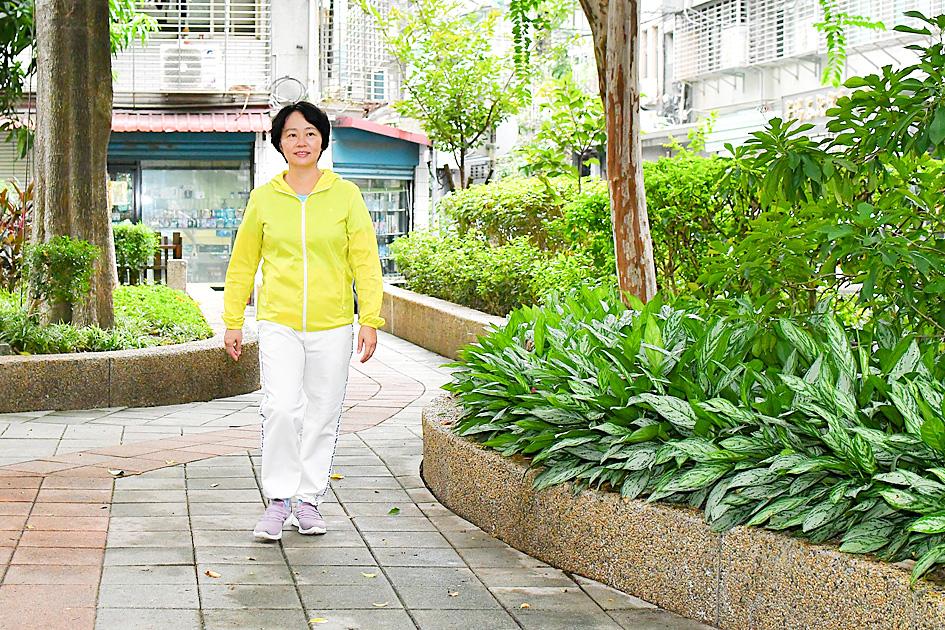The Taiwanese Osteoporosis Association yesterday urged people to start doing strength training regularly and maintain sufficient protein intake before the age of 50 to prevent loss of mobility due to aging.
Association chairman Wing Chan (陳榮邦), director of Taipei Municipal Wanfang Hospital’s Department of Radiology, said that Taiwan’s demographic structure is changing drastically and is expected to become a super-aged society by 2025.
The elderly population was only about 1.49 million (7.1 percent of the total population) in 1993, but it is expected to reach more than 4.7 million (20.1 percent of the total population) by 2025, so maintaining mobility for elderly people would become an important issue, he said.

Photo courtesy of the Taiwanese Osteoporosis Association
“About one in three people in Taiwan have hidden risks of experiencing mobility problems,” Chan said, adding that an estimated 2.86 million people have low bone density (osteoporosis), an estimated 810,000 people have low muscle mass (sarcopenia) and an estimated 3.53 million people have joint disorders or degenerative joint disease.
Bone density, joint motion and muscle mass have an interactive relationship, and middle-aged people should start taking physical mobility seriously to maintain a better life quality when they reach old age, he said.
“Standing up very slowly or needing support when standing up from a sitting position might be early warning signs of mobility loss,” Chan said, adding that the clinical evaluation of mobility include a dual energy X-ray absorptiometry, a timed walk test, a handheld dynamometer reading, and a gait and balance assessment.
Three common problems that might lead to mobility loss are “only using pain relief patches, waist belts or knee protective gear” for muscle pain or weakness; “insufficient protein and calcium intake,” as many middle-aged or elderly people believe they should eat less meat; and “believing that taking a stroll, walking a dog or riding a bicycle” is enough exercise, but they are ineffective, he said.
Chan said the majority of elderly people in Taiwan have insufficient intake of dairy products, and while many people might drink soy milk for protein, milk contains more calcium and protein, as well as whey protein, which is an important source of essential amino acids to support muscle mass.
Huang Chun-feng (黃駿豐), director of National Yang-Ming University Hospital’s Department of Family Medicine, said the best way to prevent loss of mobility is to “improve protein intake” and to both do “cardio exercises and resistance training” regularly.
He suggested doing strength training two to three sessions per week to increase muscles strength and endurance, with each session lasting one-and-a-half hours.
The exercises can be daily activities such as lifting heavy grocery bags while climbing a flight of stairs, lifting water bottles or doing squats at home, or using exercise equipment in parks.
Drinking two cups of milk per day, especially during breakfast or after exercise, is also recommended for ensuring sufficient protein intake, he added.

Taiwanese scientists have engineered plants that can capture about 50 percent more carbon dioxide and produce more than twice as many seeds as unmodified plants, a breakthrough they hope could one day help mitigate global warming and grow more food staples such as rice. If applied to major food crops, the new system could cut carbon emissions and raise yields “without additional equipment or labor costs,” Academia Sinica researcher and lead author the study Lu Kuan-jen (呂冠箴) said. Academia Sinica president James Liao (廖俊智) said that as humans emit 9.6 billion tonnes of carbon dioxide compared with the 220 billion tonnes absorbed

The Taipei Mass Rapid Transit (MRT) Wanda-Zhonghe Line is 81.7 percent complete, with public opening targeted for the end of 2027, New Taipei City Mayor Hou You-yi (侯友宜) said today. Surrounding roads are to be open to the public by the end of next year, Hou said during an inspection of construction progress. The 9.5km line, featuring nine underground stations and one depot, is expected to connect Chiang Kai-shek Memorial Hall Station to Chukuang Station in New Taipei City’s Jhonghe District (中和). All 18 tunnels for the line are complete, while the main structures of the stations and depot are mostly finished, he

Taipei is to implement widespread road closures around Taipei 101 on Friday to make way for large crowds during the Double Ten National Day celebration, the Taipei Department of Transportation said. A four-minute fireworks display is to be launched from the skyscraper, along with a performance by 500 drones flying in formation above the nearby Nanshan A21 site, starting at 10pm. Vehicle restrictions would occur in phases, they said. From 5pm to 9pm, inner lanes of Songshou Road between Taipei City Hall and Taipei 101 are to be closed, with only the outer lanes remaining open. Between 9pm and 9:40pm, the section is

China’s plan to deploy a new hypersonic ballistic missile at a Chinese People’s Liberation Army Rocket Force (PLARF) base near Taiwan likely targets US airbases and ships in the western Pacific, but it would also present new threats to Taiwan, defense experts said. The New York Times — citing a US Department of Defense report from last year on China’s military power — on Monday reported in an article titled “The missiles threatening Taiwan” that China has stockpiled 3,500 missiles, 1.5 times more than four years earlier. Although it is unclear how many of those missiles were targeting Taiwan, the newspaper reported